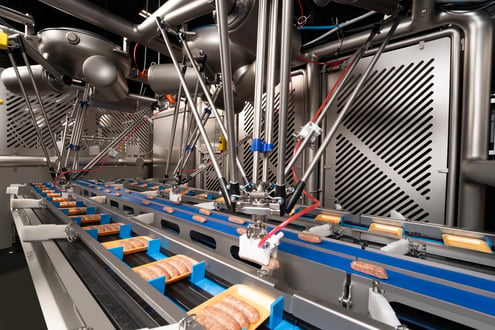
In the food packaging industry, the terms "hygienic," "sanitary," and "washdown" are often used interchangeably when describing equipment. However, these distinctions carry significant implications for food safety, operational efficiency, and long-term cost of ownership. Understanding these differences is crucial for making informed decisions about hygienic packaging machinery selection and facility design.
Defining the Terms: Hygienic Packaging Machinery and Beyond
When discussing or selecting the hygienic packaging machinery that’s right for your application, knowing the difference between wipedown and washdown is essential. Within the category of washdown packaging machine, there are also further distinctions, or ‘levels’, that are important to be aware of.
Wipedown
If a machine is described as wipedown, it means it has easy-to-clean stainless components and can be wiped down for cleaning. However, it cannot be hosed down without jeopardizing the integrity of the machine. This is for several reasons, including ingress concerns and insufficient durability.
For instance, these machines contain electric components such as motors, sensors, and wiring that can be damaged by water exposure. Since extra care is not taken to prevent water ingress, things like short circuits, corrosion, and equipment failure are possible.
Unlike washdown-rated equipment, which we’ll talk about more in a little bit, wipedown machines aren't built with the proper IP (Ingress Protection) ratings needed to withstand water spray or immersion. Seals, gaskets, and enclosures may not be waterproof, and as a result, the risk of bacterial harborage increases in hidden spaces, crevices, or internal components.
Additionally, the materials used (electronics housings, bearings, etc.) may not be designed to resist moisture and cleaning chemicals used in washdown procedures. Water pressure from washdown procedures can force moisture into bearings, drive components, and other mechanical parts not designed for wet environments, leading to premature wear and failure.
Washdown
The term “washdown” is used to refer to an environmental condition where a piece of equipment, like a packaging machine, will be in operation. Washdown usually implies the need for hygienic design. However, that is not automatically, or expressively the case. Washdown simply means that the equipment will be wet during operation or cleaning. The degree of harshness for washdown conditions will vary significantly depending on the application or machine use case. A machine suitable for washdown alone simply means the equipment is rated (IP65-IP69K) by design to be suitable for withstanding certain washdown procedures. Again, washdown procedures will vary depending on application.
Within the category of washdown, there are four further distinctions:
1. Non-Sanitary These machines are not specifically designed to eliminate harborage areas and can use a low-pressure hose for washdown without chemicals. They can have a combination of stainless steel and non-stainless-steel components, such as anodized aluminum or painted carbon steel. These machines would be ideal for items that don’t require adhering to strict requirements, such as packaged foods like pasta or candy where the machine handles the package, rather than touching the food item.
2. Sanitary The term “sanitary” refers to conditions that are clean and free from dirt, bacteria, germs, and so on that can pose a risk to health. The degree of effectiveness and ease of effort to sanitize something (or make sanitary, like a packaging machine) is dependent on the process used for sanitation and the design of the equipment to be sanitized, or, to make the equipment hygienic. Sanitary design is not really a thing. To be hygienically designed is to be suitable for becoming sanitary with proper cleaning and sanitation procedures.
sanitation and the design of the equipment to be sanitized, or, to make the equipment hygienic. Sanitary design is not really a thing. To be hygienically designed is to be suitable for becoming sanitary with proper cleaning and sanitation procedures.
Machines with this designation are designed for some, but not all, harborage areas to be eliminated. They are constructed with stainless steel and can use a low-pressure hose, but without chemicals, just water. Sanitary washdown machines are ideal for a wide variety of food items such as snacks, wrapped bakery items, candy, pet food, and more that do not come in direct contact with the machine.
3. Hygienic The term “hygienic” essentially refers to something that is designed to protect health and reduce the risk of illness by minimizing the possibility of contamination and promoting cleanliness. Hygienic by design is real.
When a machine is hygienic washdown, it can undergo high-pressure washdown with the use of chemicals. The machine typically has a hollow-body frame construction and extra effort is made to ensure all harborage areas are eliminated (special finishes, ground welds, standoffs, sloped surfaces, etc.). These machines are ideal for fresh foods, IQF products, ready-to-eat (RTE) foods and more.
For a machine to be designated hygienic, the equipment up and downstream from it must also meet the same specifications [such as Ingress Protection (IP) ratings]. This is because if an IP65 rated component is mounted next to IP69K equipment, the lower-rated component becomes vulnerable during high-pressure, high-temperature washdown procedures. Repeated exposure to IP69K washdown conditions may cause water ingress over time, leading to premature failure of the IP65 component.
One important element of hygienic design is the ability to inspect all surfaces of a piece of equipment. Both visual inspection and physical inspection, as well as the ability to touch all surfaces with a swab to test for bacteria, are critically important in hygienic design. For this reason, tubular construction is avoided since you cannot inspect the surfaces on the inside of tubing. Rotating tubes, like a hollow film roller, should be fully sealed by welding and then filled with several ounces of blue food coloring to expose any cracks that develop over time. Avoiding small harborage cavities like the hex slot in a socket head cap screw should also be avoided in favor of standard head fasteners.
4. Ultra-Hygienic  The strictest of all designations, ultra-hygienic washdown machines have the same features as hygienic washdown machines, except they have an open-channel frame or solid barstock construction. An open-channel frame is made with bent solid stainless-steel sheets or plates to form upright sections and cross-members, further eliminating harborage points compared to hollow-body alternatives. These machines adhere to 3-A standards and are ideal for industries such as dairy, meat, seafood and produce.
The strictest of all designations, ultra-hygienic washdown machines have the same features as hygienic washdown machines, except they have an open-channel frame or solid barstock construction. An open-channel frame is made with bent solid stainless-steel sheets or plates to form upright sections and cross-members, further eliminating harborage points compared to hollow-body alternatives. These machines adhere to 3-A standards and are ideal for industries such as dairy, meat, seafood and produce.
Understanding these distinctions ensures that your packaging machinery investment supports both food safety objectives and operational efficiency while minimizing long-term maintenance costs and compliance risks.
Need a washdown packaging machine and not sure where to start? We’ve seen it all and are ready to help.
Sources
International Electrotechnical Commission (IEC). "Ingress Protection (IP) ratings." https://www.iec.ch/ip-ratings
Clarion UK. "IP Ratings Explained | Ingress Protection Rating | IP Codes." October 4, 2022. https://clarionuk.com/resources/ip-ratings/
Things Embedded USA. "Importance of High Ingress Protection: IP65, IP66, IP67, IP68, IP69K." September 4, 2023. https://things-embedded.com/us/white-paper/importance-of-high-ingress-protection-ip65-ip66-ip67-ip68-ip69k/\
.png?noresize&width=1000&height=400&name=JLS-70th-Homepage-Logo%20(1).png)
.png?noresize&width=500&height=200&name=JLS-70th-Homepage-Logo%20(1).png)
